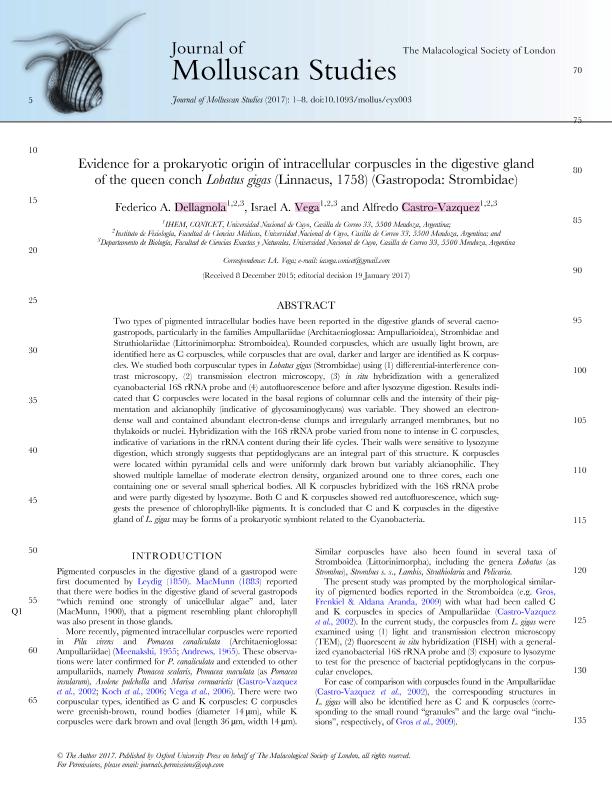Artículo
Evidence for a prokaryotic origin of intracellular corpuscles in the digestive gland of the queen conch Lobatus gigas (Linnaeus, 1758) (Gastropoda: Strombidae)
Fecha de publicación:
05/2017
Editorial:
Oxford University Press
Revista:
Journal of Molluscan Studies
ISSN:
0260-1230
Idioma:
Inglés
Tipo de recurso:
Artículo publicado
Clasificación temática:
Resumen
Two types of pigmented intracellular bodies have been reported in the digestive glands of several caenogastropods, particularly in the families Ampullariidae (Architaenioglossa: Ampullarioidea), Strombidae and Struthiolariidae (Littorinimorpha: Stromboidea). Rounded corpuscles, which are usually light brown, are identified here as C corpuscles, while corpuscles that are oval, darker and larger are identified as K corpuscles. We studied both corpuscular types in Lobatus gigas (Strombidae) using (1) differential-interference contrast microscopy, (2) transmission electron microscopy, (3) in situ hybridization with a generalized cyanobacterial 16S rRNA probe and (4) autofluorescence before and after lysozyme digestion. Results indicated that C corpuscles were located in the basal regions of columnar cells and the intensity of their pigmentation and alcianophily (indicative of glycosaminoglycans) was variable. They showed an electrondense wall and contained abundant electron-dense clumps and irregularly arranged membranes, but no thylakoids or nuclei. Hybridization with the 16S rRNA probe varied from none to intense in C corpuscles, indicative of variations in the rRNA content during their life cycles. Their walls were sensitive to lysozyme digestion, which strongly suggests that peptidoglycans are an integral part of this structure. K corpuscles were located within pyramidal cells and were uniformly dark brown but variably alcianophilic. They showed multiple lamellae of moderate electron density, organized around one to three cores, each one containing one or several small spherical bodies. All K corpuscles hybridized with the 16S rRNA probe and were partly digested by lysozyme. Both C and K corpuscles showed red autofluorescence, which suggests the presence of chlorophyll-like pigments. It is concluded that C and K corpuscles in the digestive gland of L. gigas may be forms of a prokaryotic symbiont related to the Cyanobacteria.
Palabras clave:
Endosymbiosis
,
Digestive Gland
,
Littorinimorpha
,
Strombidae
Archivos asociados
Licencia
Identificadores
Colecciones
Articulos(IHEM)
Articulos de INST. HISTOLOGIA Y EMBRIOLOGIA DE MEND DR.M.BURGOS
Articulos de INST. HISTOLOGIA Y EMBRIOLOGIA DE MEND DR.M.BURGOS
Citación
Dell Agnola, Federico Agustín; Vega, Israel Aníbal; Castro Vazquez, Alfredo Juan; Evidence for a prokaryotic origin of intracellular corpuscles in the digestive gland of the queen conch Lobatus gigas (Linnaeus, 1758) (Gastropoda: Strombidae); Oxford University Press; Journal of Molluscan Studies; 83; 2; 5-2017; 186-193
Compartir
Altmétricas




